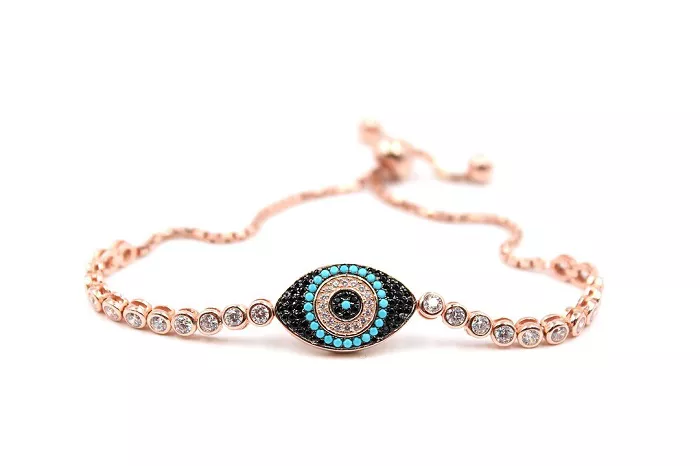The turquoise evil eye is a fascinating symbol with a rich history that spans cultures and centuries. This article delves into the origins, meanings, and uses of the turquoise evil eye, exploring its significance in modern times.
Origins of the Evil Eye
Ancient Beginnings
The concept of the evil eye dates back to ancient civilizations, including the Greeks, Romans, Egyptians, and Mesopotamians. These cultures believed that certain individuals possessed the power to cause harm or misfortune merely by looking at someone with envy or malice. This harmful gaze was termed the “evil eye.”
Cultural Spread
As cultures interacted through trade, conquest, and migration, the belief in the evil eye spread across the Mediterranean and into the Middle East, South Asia, and even parts of Europe. Each culture adapted the belief to fit their local traditions and symbols, resulting in a variety of protective amulets and rituals to ward off the evil eye.
The Symbolism of Turquoise
Historical Significance
Turquoise is a gemstone that has been valued for thousands of years. Ancient Egyptians used turquoise in jewelry and amulets, believing it brought protection and good fortune. Native American cultures also revered turquoise, considering it a sacred stone that connected the physical and spiritual worlds.
Spiritual and Healing Properties
Turquoise is often associated with tranquility, protection, and healing. It is believed to absorb negative energies and provide a sense of calm and balance. This makes it an ideal stone for creating protective amulets, such as the turquoise evil eye.
The Evil Eye Amulet
Design and Features
The evil eye amulet, also known as Nazar, is traditionally made of blue glass and designed to resemble an eye. The eye motif is believed to reflect the evil gaze back to the sender, thus protecting the wearer. When turquoise is incorporated into the design, it adds an additional layer of meaning and protection.
Variations Across Cultures
While the classic blue evil eye is most common, variations can be found in different cultures. In some regions, the evil eye amulet may include additional colors or materials, each adding its own significance. The turquoise evil eye is one such variation, combining the protective qualities of the evil eye with the soothing and healing properties of turquoise.
The Meaning of the Turquoise Evil Eye
Protection Against Negative Energy
The primary purpose of the turquoise evil eye is to protect the wearer from negative energy, envy, and harm. The turquoise stone enhances this protective function by absorbing negative vibrations and promoting a sense of peace and security.
Symbol of Good Fortune
In addition to protection, the turquoise evil eye is often seen as a symbol of good fortune and prosperity. Many believe that wearing the turquoise evil eye can attract positive energy, success, and happiness into one’s life.
Spiritual Balance and Healing
Turquoise is known for its ability to promote emotional and spiritual balance. Wearing a turquoise evil eye can help individuals feel more centered and grounded, reducing stress and anxiety. It is also believed to aid in physical healing, particularly for issues related to the throat and respiratory system.
Modern Uses and Popularity
Fashion and Jewelry
The turquoise evil eye has become a popular motif in contemporary fashion and jewelry. Designers incorporate the symbol into necklaces, bracelets, earrings, and rings, creating stylish pieces that also serve as protective amulets. This trend has made the turquoise evil eye accessible to a wider audience, spreading its protective and positive qualities.
Home Decor and Art
Beyond personal adornment, the turquoise evil eye is also used in home decor and art. Many people hang evil eye amulets in their homes, workplaces, and vehicles to ward off negative energy and create a harmonious environment. Artists often incorporate the symbol into their works, using it as a motif for protection and spiritual well-being.
Cultural and Religious Practices
In some cultures and religious practices, the turquoise evil eye continues to play a significant role. It is used in rituals, ceremonies, and daily life to invoke protection and blessings. The symbol’s enduring presence in these traditions highlights its deep-rooted significance and universal appeal.
See Also: Can Anyone Wear a Turquoise Ring?
Scientific Perspectives
Psychology of Belief
From a psychological standpoint, the belief in the protective power of the turquoise evil eye can have real effects on individuals. The placebo effect, where belief in the efficacy of a treatment or object leads to positive outcomes, may explain why many people feel safer and more secure when wearing or displaying the turquoise evil eye.
Cultural Anthropology
Anthropologists study the turquoise evil eye as part of a broader examination of cultural symbols and their meanings. This research helps to understand how symbols like the turquoise evil eye function within societies, providing insight into human behavior, belief systems, and cultural transmission.
Conclusion
The turquoise evil eye is a powerful symbol that combines ancient beliefs with modern significance. Its protective properties, association with good fortune, and ability to promote spiritual balance make it a cherished amulet across cultures. Whether worn as jewelry, displayed in the home, or used in rituals, the turquoise evil eye continues to inspire and protect people worldwide.
Understanding the multifaceted meanings and uses of the turquoise evil eye allows us to appreciate its enduring appeal and the deep connections it fosters between individuals, cultures, and history. This symbol is more than just a piece of jewelry or decor; it is a testament to the human desire for protection, prosperity, and peace.


